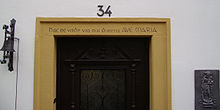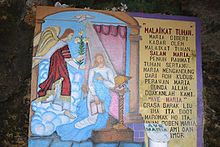Hail Mary
![]()
This article is about the prayer Ave Maria. For other meanings, see Ave Maria (disambiguation).
Ave Maria (Hail Mary) is the Latin beginning and at the same time the name of a basic prayer of the Catholic Church to invoke Mary, the mother of Jesus Christ. Ave is a Semitic loanword that has penetrated Latin and probably originated in Carthage (Phoenician-Punic hawe means "live").
A prayer essentially corresponding to the Hail Mary is also known in the Orthodox Churches.
There are two parts to the invocation:
- The first part consists of the biblical Marian addresses of the Archangel Gabriel at the Annunciation of the Lord (Lk 1:28 EU) (English greeting) and of Elizabeth at the visitation of Mary (Lk 1:42 EU). This part has been prayed in the Liturgy of the Hours and in devotions since the 11th century.
- The second part is the request for assistance in the hour of death, which was officially added by Pius V in 1568.
After the Lord's Prayer, the Hail Mary is one of the most recited prayers in Christianity and is also part of the Angelus and the Rosary.

The Annunciation Fra Angelico, 1433-34

Latin inscription above the entrance to the rectory of Tiefenpölz: "Do not enter without saying a Hail Mary!"
Eastern ecclesiastical form
The Hail Mary of the Eastern Church reads:
Greek:
Θεοτόκε Παρθένε, χαῖρε,κεχαριτωμένη
Μαρία, ὁ Κύριος μετὰ σοῦ.
εὐλογημένη σὺ ἐν γυναιξί,καὶ εὐλογημένος ὁ καρπὸς τῆς κοιλίας σου,
ὅτι Σωτῆρα ἔτεκες τῶν ψυχῶν ἡμῶν.
German:
Hail
Mary, Mother of God and Virgin,
the Lord is with you.
Blessed are you among women,
and blessed is the fruit of your womb,
because you have given birth to the Saviour of our souls.
Western church form
The Hail Mary of the Western Church, the Roman Catholic Church and the Anglican Church reads:
Latin:
Ave Maria, gratia plena,
Dominus tecum.
Benedicta
tu in mulieribus,
et benedictus fructus ventris tui, Iesus.
Sancta Maria, Mater Dei,
ora pro nobis peccatoribusnunc
et in hora mortis nostrae.
Amen.
German:
Hail Mary, full of grace,
the Lord is with you.
Blessed art thou among women,
and blessed is the fruit of thy womb, Jesus.
Holy Mary, Mother of God, pray for us sinners now
and at the hour of our death.
Amen.
In it the word gebenedeit (from the infinitive benedeien) is the Germanized form of the Latin participle benedictus (German: gesegnet; to the infinitive benedicere). In contrast to the German word "segnen", however, benedicere can mean not only God's bestowal of a blessing on a person, but also the act of worship by the individual praying or the congregation. Thus, God can also be "gebenedeit" (worshipped, glorified). Since there is no German equivalent to benedicere (literally: to speak well) that takes both meanings into account, this Germanized form is often used instead of a translation.
The German version used to read "Thou art blessed among women", and there were also versions which read "pray for us poor sinners now and in the hour of our dying".

The Ave Maria in Indonesian and Tetum

Greeting of the angel in front of the main altar of Zinna monastery
Questions and Answers
Q: What is the Hail Mary prayer?
A: The Hail Mary is a Christian prayer to Mary, the mother of Jesus.
Q: Where does most of the Hail Mary prayer come from?
A: Most of the prayer comes from the Gospel of Luke.
Q: When were some things added to the Hail Mary prayer?
A: Some things were added to the prayer during the 13th century (the 1200s).
Q: When a person says a Hail Mary, what are they asking Mary to do?
A: When a person says a Hail Mary, they are asking Mary to pray for them.
Q: In which branch of Christianity is the Hail Mary the most prevalent prayer in the Rosary?
A: In Roman Catholicism, the Hail Mary is the most prevalent prayer in the Rosary.
Q: Which other Christian branches use the Hail Mary prayer?
A: The Eastern Orthodox and Oriental Orthodox also use the prayer, as do many other groups within Christianity, including Anglicans, Independent Catholics, and Old Catholics.
Q: Do some Protestant denominations use the Hail Mary prayer?
A: Yes, some Protestant denominations also use the Hail Mary.
Search within the encyclopedia